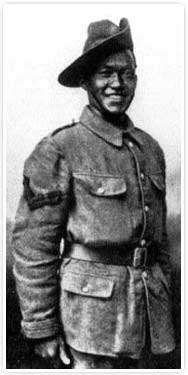Kulbir Thapa
show This article may be expanded with text translated from the corresponding article in Russian. (August 2021) Click [show] for important translation instructions. |
Kulbir Thapa Magar | |
|---|---|
 | |
| Born | 15 December 1888 Palpa, Nepal |
| Died | 3 October 1956 (aged 67) |
| Allegiance | |
| Service/ | |
| Rank | Havildar |
| Unit | 3rd Queen Alexandra's Own Gurkha Rifles |
| Battles/wars | World War I |
| Awards | |
Kulbir Thapa Magar VC (15 December 1888 – 3 October 1956) was the first Nepalese Gurkha recipient of the Victoria Cross, the highest and most prestigious award for gallantry in the face of the enemy that can be awarded to British and Commonwealth forces.
Biography[]
Born on 15 December 1888 in Palpa, Nepal, to Haria Gulte.[1]
Thapa was a 26-year-old Rifleman in the 2nd Battalion, 3rd Queen Alexandra's Own Gurkha Rifles, British Indian Army, during the First World War when the following deed took place for which he was awarded the Victoria Cross. On 25 September 1915 in Fauquissart, France Rifleman Kulbir Thapa, having been wounded himself, found a wounded soldier of The Leicestershire Regiment behind the first-line German trench (believed to be a 20-year-old soldier from Melton Mowbray by the name of Bill Keightley). Although urged to save himself, the Gurkha stayed with the wounded man all day and night. Early next day, in misty weather, he dragged him through the German wire, within spitting distance from the Germans, and, leaving him in a place of comparative safety, returned and brought in two wounded Gurkhas, one after the other. He then went back, and, in broad daylight, fetched the British soldier, carrying him most of the way under enemy fire.[2]
Such an incredible act of faith and courage had by now attracted a good deal of attention, and when he emerged from his trench for the third time with one more wounded comrade over his shoulder, the German soldiers actually clapped their hands to encourage the Gurkha on. Only this time, the Gurkha walked right across the No-Mans-Land back to his own side.[citation needed]
The Victoria Cross awarded to Kulbir Thapa was in the first group of awards for the Battle of Loos which were gazetted on 18 November 1915. Of the 18 VCs gazetted that day no less than 17 were presented by the King at Buckingham Palace in nine presentations between December 1915 and January 1917. Kulbir Thapa rejoined his battalion in Egypt on 4 January 1916 and no record as to when he received his medal has been located.[3]
He later achieved the rank of Havildar.
Legacy[]
His Victoria Cross is displayed at The Gurkha Museum in Winchester, Hampshire, England. The Royal Mail issued a 1st class stamp featuring his portrait in their second set of six stamps marking anniversaries of the First World War in May 2015.[4]
In popular culture[]
References[]
- ^ Kulbir Thapa at the Wayback Machine (archived 10 March 2007)
- ^ "No. 29371". The London Gazette (Supplement). 16 November 1915. p. 11450.
- ^ Victoria Cross presentations and locations. Dennis Pillinger and Anthony Staunton, Woden, ACT, 2000.
- ^ The Royal Mail Newspaper Courier, May 2015
- ^ Bajracharya, Srizu (3 February 2020). "Remembering the valour of the Gurkhas". The Kathmandu Post. Retrieved 21 January 2021.
- ^ "Khukri Rum". 28 August 2020. Retrieved 21 January 2021.
- Monuments to Courage (David Harvey, 1999)
- The Register of the Victoria Cross (This England, 1997)
- VCs of the First World War - The Western Front 1915 (Peter F. Batchelor & Christopher Matson, 1999)
See also[]
| Wikimedia Commons has media related to Kulbir Thapa. |
- 1889 births
- Nepalese World War I recipients of the Victoria Cross
- British Indian Army soldiers
- 1956 deaths
- Gurkhas
- People from Palpa District
- Nepalese people of World War I